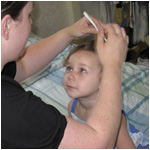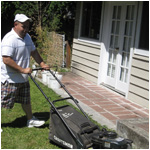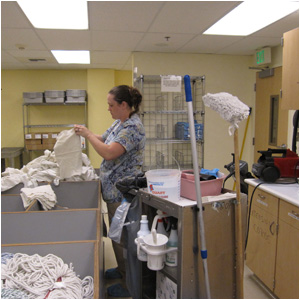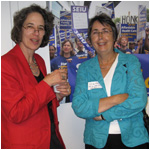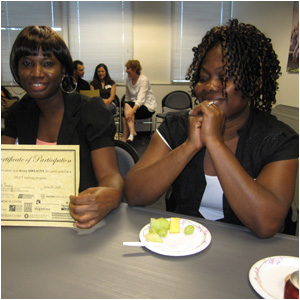College Goes to Work
Nearly a third of Americans with jobs live on the edge of poverty. That's tens of millions of working people who struggle to pay their bills. Candace Picazo is among them. She's a part-time housekeeper at a hospital earning about $300 a week.
Candace begins each shift in the basement laundry room of Valley Medical Center in Renton, just southeast of Seattle.
"I'm really picky about my rags," she says, sorting through a big bin. The white cloths all look the same, but Candace examines many before selecting about a dozen to fold and stack on her cart. She prefers old blankets.
"They're very absorbent and they clean well," she says. "I think something as simple as this can affect your day at work. Something small, you know?"
But Candace is hoping for something bigger, too. She wants to move on from dusting and wiping and emptying trash cans at the hospital. She wants to become a nurse.
Until recently, Candace couldn't figure out how to get there. She'd thought about college, but couldn't afford it.
Now she's in a Washington state program that pays her tuition.
It's called Health Employees Education and Training, or HEET.
It's a collaboration among six hospitals, the Service Employees International Union, eight community colleges and the state of Washington.
The idea is to create a bridge between the classroom and the workplace. It's part of a nationwide movement to help two-year colleges be more responsive to student needs and get them into the mainstream economy.
What Candace needed was help with tuition.
She and her husband raise their toddler in a tiny two-bedroom home on a busy corner of a blue-collar suburb. Most of the nearby housing is in mobile home parks. Four years ago they were thrilled to be able to get a mortgage "on a house on its own foundation." But now they want more. "It's hard to keep the baby inside," Candace says. She worries about all the traffic on their street. They dream of joining the middle class: another child, a bigger house, paid health insurance.
She says she wasn't ready after high school. Just graduating was an accomplishment. Neither of her parents earned a high school diploma, and only one of her two siblings did.
"I didn't have a big college dream," she says. "I was tired of all the homework and I was thinking, OK, I'm going to take a break."
After high school, Candace worked a variety of minimum-wage jobs, including one at a Mexican restaurant. That's where she met her husband, Juan Carlos, the co-owner of the restaurant. Juan Carlos's 10 siblings are owners too, so even though the restaurant does well each family needs a second income. It was Juan Carlos who thought Candace belonged in health care.
"He asked me to do something of importance to my community," she remembers. "And I told him, 'You're crazy. How am I going to get into a position where I can really make a difference without having a college education?'"
Last summer Candace took the three-day-a-week housekeeping position just to work in a hospital. She makes $12.30 an hour. She gets health insurance for herself, but not for Maria or Juan Carlos. She'd been on the job three months when the HR department attached a notice to her paycheck. It said, "Do you want to be a Certified Nursing Assistant or an Emergency Room Tech?" The notice went to several hundred housekeepers, janitors and cafeteria workers in hospitals throughout Washington. It offered them a chance to move into higher-skilled, better paying jobs.
"It's a win for the employee, the hospital and the community," says Jaime Garcia, who runs the Health Work Force Institute for the Washington State Hospitals Association.
Hospitals are going to need more staff to deal with the health needs of aging baby boomers, Garcia says. HEET gives hospitals a chance to retain and promote motivated workers.
"We don't have enough people in the pipeline, in the nursing programs, so we need to use our own, grow our own," Garcia says. "What's in it for hospitals is their future workforce, which is working for them right now in housekeeping, janitorial, dietary and transportation."
The five hospitals that participate in HEET have ponied up $300,000. They also contribute staff for teaching, space for on-the-job classrooms and flexible schedules to give workers time off for school.
The union, which represents 22,000 health care workers in Washington state, is administering the program. It says entry-level workers who are familiar with hospitals are a good bet for promotion compared with students in nursing programs, more than a third of whom quit in the first two years.
"You go to school, you're quite idealistic, you get out of school, you hit the hospital floor and all of a sudden you have horrendous workload issues," says Diane Sosne, a registered nurse and president of SEIU Local 1199NW.
She says most nursing schools don't prepare students for the stress of hospital jobs.
"We want to work with colleges to redesign the delivery side of education, taking into account hospitals are very rich learning environments."
Now health care workers who clean rooms and prepare meals are learning patient care in the hospital wards where they already work.
The HEET program is an example of a larger movement in two-year colleges that started in Washington state and is now spreading across the country.
Washington is trying to think about post-secondary education systematically, so that students who enroll in community college have jobs waiting for them when they finish.
The state began piloting its so-called integrated approach about five years ago in 10 of its two-year colleges. It worked so well at improving student earning that now all 34 colleges are implementing it. The idea is that students will get credit for real-world experience. As they advance in workplaces or job sectors they already know, they'll get support from their colleges, their employers and their communities.
"They're able to learn both the academic side and the occupational skills at the exact same time," says Israel Mendoza, director of Adult Basic Education for the Washington State Board for Community and Technical Colleges.
It's not just in health care. Mendoza says that demand for skilled workers is high in Washington state - in accounting, trucking and manufacturing, for example. The programs he runs encourage entry-level workers to acquire some college along with new skills.
"Most of them do not believe they're college material, do not believe they will ever have an opportunity for those jobs at the top of the career ladder," Mendoza says.
"The bottom line for all of this is it shortens time for low-income folks to move in a real legitimate pathway that will take them as far as they want to go. They didn't have the formal education or the family income or support or don't view themselves as being able to reach those positions. This is going to change that."
Mendoza says if community colleges want to help low-income students become self-sufficient, they will help them commit to a career path.
"The tipping point is a year's worth of college credits and a credential of any kind," says Mendoza. "If you had those two things five years later, you were earning more money than someone like you without that combination."
President Obama often cites the tipping point research from Washington State when he encourages young people to set goals, finish high school and complete at least a year of post-secondary school.
This fall, Candace Picazo reached "the tipping point." She took three college classes including one that required 96 hours of clinical practice under nurses' supervision at the hospital. Candace had to take patient vital signs, feed those who couldn't feed themselves, and escort them out when they went home.
"I like interacting with the patients," she says. "It feels like you can actually help them heal because we're the ones closest to them, taking care of them."
When the school year ended in June, 2009, SEIU held a party at the union hall to celebrate the success of the program's 80 first-year participants.
It's a diverse group: male and female, all ages and many ethnic backgrounds. About a third are recent immigrants. They sit at long tables, surrounded by friends and family.
When Candace gets her certificate, her parents beam and her 2-year-old dances in the aisle.
"Thank you for this wonderful opportunity," she tells the educators, hospital administrators and union officials gathered for the occasion. "Without you we'd be stuck," she says.
Instead, she's a step closer to her goal.
In September Candace passed the certification test to become a nursing assistant. She expects to get her license in November.
The hospital where she works is opening a new wing this winter. That will mean thousands of new patients a day and 19 new staff members to care for them. Candace will apply for a fulltime job taking care of patients. If she's hired, she'll get a hefty raise and health insurance for her family. In the spring she can rack up more credentials: one to draw blood, another to assist with EKGs. She can get certified in wound care and infection control. That will qualify her to work in the emergency room. And all those classes will count toward her nursing license.
"I love to learn and as long as I have the opportunity to, I will continue," she says. "I hope to one day be something big."
Back to Workplace U.



